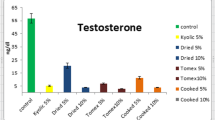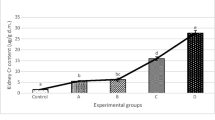Abstract
Some medications may change trace element levels in the body. Extracts of various plants, due to having the several elements, can have beneficial effects. Consumption of herbal extracts with chemical drugs may reduce adverse effects of medication. The goal of this study was to evaluate copper (Cu), zinc (Zn), and manganese (Mn) concentrations in serum of rats treated with tamoxifen, chicory, and/or milk thistle extracts. Therefore, 36 adult female Wistar rats were divided into six groups: normal control, chicory control, milk thistle control, tamoxifen, tamoxifen-chicory, and tamoxifen-milk thistle. At the end of the study, the blood samples were collected and sera isolated by centrifugation and analyzed by the atomic absorption spectrophotometry for Cu, Zn, and Mn levels. The Zn concentration increased in milk thistle-supplemented groups. The Cu level increased in the chicory control group only. Tamoxifen had no affect on Cu, Zn, and Mn levels, but seed extract of milk thistle increased Zn concentration, and chicory root extract increased Cu concentration. Although elevated levels of Cu in rats receiving tamoxifen-chicory were milder than rats treated only with chicory, it seems that the extract and tamoxifen impact on the Cu are in conflict with each other.
Similar content being viewed by others
References
Soetan K, Olaiya C, Oyewole O (2010) The importance of mineral elements for humans, domestic animals and plants: a review. Afr J Food Sci 4:200–222
Osredkar J, Sustar N (2011) Copper and zinc, biological role and significance of copper/zinc imbalance. J Clin Toxicol S3:001
Salgueiro M, Zubillaga MB, Lysionek AE, Caro RA, Weill R, Boccio JR (2002) The role of zinc in the growth and development of children. Nutrition 18:510–519
Prohaska JR (1990) Biochemical changes in copper deficiency. J Nutr Biochem 1:452–461
Levy BS, Nassetta WJ (2003) Neurologic effects of manganese in humans: a review. Int J Occup Environ Health 9:153–163
Ghayour-Mobarhan M, Lamb DJ, Taylor A, Vaidya N, Livingstone C, Wang T, Ferns GA (2005) Effect of statin therapy on serum trace element status in dyslipidaemic subjects. J Trace Elem Med Biol 19:61–67
Kürekçi AE, Alpay F, Tanindi Ş, Gokçay E, Ozcan O, Akin R, Işimer A, Sayal A (1995) Plasma trace element, plasma glutathione peroxidase, and superoxide dismutase levels in epileptic children receiving antiepileptic drug therapy. Epilepsia 36:600–604
Nowak G, Schlegel-Zawadzka M (1999) Alterations in serum and brain trace element levels after antidepressant treatment. Biol Trace Elem Res 67:85–92
Tekin D, Taşdemir HA, Saraymen R (2008) The effects of antiepileptic drugs on serum and hair trace element levels. Ankara Üniversitesi Tıp Fakültesi Mecmuası 61:073–076
El-Beshbishy HA (2005) The effect of dimethyl dimethoxy biphenyl dicarboxylate (DDB) against tamoxifen-induced liver injury in rats: DDB use is curative or protective. J Biochem Mol Biol 38:70–77
Adashi E, Hsueh A, Bambino TH, Yen S (1981) Disparate effect of clomiphene and tamoxifen on pituitary gonadotropin release in vitro. Am J Physiol Endocrinol Metab 240:E125–E130
Gill-Sharma M, Balasinor N, Parte P, Aleem M, Juneja H (2001) Effects of tamoxifen metabolites on fertility of male rat. Contraception 63:103–109
Ziamajidi N, Khaghani S, Hassanzadeh G, Vardasbi S, Ahmadian S, Nowrouzi A, Ghaffari SM, Abdirad A (2013) Amelioration by chicory seed extract of diabetes- and oleic acid-induced non-alcoholic fatty liver disease (NAFLD)/non-alcoholic steatohepatitis (NASH) via modulation of PPARα and SREBP-1. Food Chem Toxicol 58:198–209
El-Sayed YS, Lebda MA, Hassinin M, Neoman SA (2015) Chicory (Cichorium intybus L.) root extract regulates the oxidative status and antioxidant gene transcripts in CCl4-induced hepatotoxicity. PLoS One 10:e0121549
Behrouj H, Ziamajidi N, Abbasalipourkabir R, Nasiri A, Soleimani-Asl S (2015) Therapeutic effect of Silybum marianum plant extract on tamoxifen-induced fatty liver in rats. Avicenna J Med Biochem 3, e27160
El-Beshbishy HA (2005) Hepatoprotective effect of green tea (Camellia sinensis) extract against tamoxifen-induced liver injury in rats. J Biochem Mol Biol 38:563–570
Shaker E, Mahmoud H, Mnaa S (2010) Silymarin, the antioxidant component and Silybum marianum extracts prevent liver damage. Food Chem Toxicol 48:803–806
Kim M, Shin HK (1998) The water-soluble extract of chicory influences serum and liver lipid concentrations, cecal short-chain fatty acid concentrations and fecal lipid excretion in rats. J Nutr 128:1731–1736
Ozturk M, Akdogan M, Keshin I, Kisioglu AN, Oztas S, Yildiz K (2012) Effect of Silybum marianum in acute hepatic damage caused by carbon tetrachloride in rats. Biomed Res 23:268–274
Lien EA, Solheim E, Ueland PM (1991) Distribution of tamoxifen and its metabolites in rat and human tissues during steady-state treatment. Cancer Res 51:4837–4844
Gursel FE, Ates A, Bilal T, Altiner A (2012) Effect of dietary Garcinia cambogia extract on serum essential minerals (calcium, phosphorus, magnesium) and trace elements (iron, copper, zinc) in rats fed with high-lipid diet. Biol Trace Elem Res 148:378–382
Smith JC Jr, Butrimovitz GP, Purdy WC (1979) Direct measurement of zinc in plasma by atomic absorption spectroscopy. Clin Chem 25(8):1487–1491
Agada PO, Braide BD (2009) Effect of dietary Garcinia kola seed on selected serum electrolytes and trace metals in male albino rats. Niger J Physiol Sci 24(1):53–57
Nada S, Al-Taee N (2013) Effect of seeds extraction of Lepidium sativum on zinc and iron elements and some biochemical parameters in serum of white male rabbits. Euphrates J Agric Sci 5(1):23–35
Joshaghani H, Amiriani T, Vaghari G, Besharat B, Molana A, Badeleh M (2012) Effects of omeprazole consumption on serum levels of trace elements. J Trace Elem Med Biol 26:234–237
Evans-Brown M, Kimergård A, McVeigh J, Chandler M, Brandt SD (2014) Is the breast cancer drug tamoxifen being sold as a bodybuilding dietary supplement? BMJ 348:1476
Liu CL, Huang JK, Cheng SP, Chang YC, Lee JJ, Liu TP (2006) Fatty liver and transaminase changes with adjuvant tamoxifen therapy. Anticancer Drugs 17:709–713
Nishino M, Hayakawa K, Nakamura Y, Morimoto T, Mukaihara S (2003) Effects of tamoxifen on hepatic fat content and the development of hepatic steatosis in patients with breast cancer: high frequency of involvement and rapid reversal after completion of tamoxifen therapy. Am J Roentgenol 180:129–134
Mourits MJ, De Vries EG, Willemse PH, Ten Hoor KA, Hollema H, Van der Zee AG (2001) Tamoxifen treatment and gynecologic side effects: a review. Obstet Gynecol 97:855–866
Ferlini C, Scambia G, Marone M, Distefano M, Gaggini C, Ferrandina G, Fattorossi A, Isola G, Panici PB, Mancuso S (1999) Tamoxifen induces oxidative stress and apoptosis in oestrogen receptor-negative human cancer cell lines. Br J Cancer 79:257–263
Antila HM, Salo MS, Näntö V, Nikkanen V, Kirvelä O (1992) The effect of postoperative radiotherapy on leukocyte zinc, serum trace elements and nutritional status of breast cancer patients. Acta Oncol 31:569–572
Gündüz H, Dede S, Agaoglu ZT, Atasoy N, Mert N (2002) Serum trace elements status of rabbits supplemented with Nigella sativa, vitamins C and E, and selenium against damage by N-methyl-N′-nitro-N-nitrosoguanidine. Biol Trace Elem Res 89(1):65–73
Author information
Authors and Affiliations
Corresponding author
Ethics declarations
Funding
This study was financially supported by Hamadan University of Medical Sciences.
Conflict of Interest
The authors declare that they have no competing interests.
Rights and permissions
About this article
Cite this article
Abbasalipourkabir, R., Ziamajidi, N., Nasiri, A. et al. Effects of Aqueous Extracts of Chicory and Milk Thistle on Serum Concentrations of Copper, Zinc, and Manganese in Tamoxifen-Treated Rats. Biol Trace Elem Res 173, 140–143 (2016). https://doi.org/10.1007/s12011-016-0629-z
Received:
Accepted:
Published:
Issue Date:
DOI: https://doi.org/10.1007/s12011-016-0629-z




